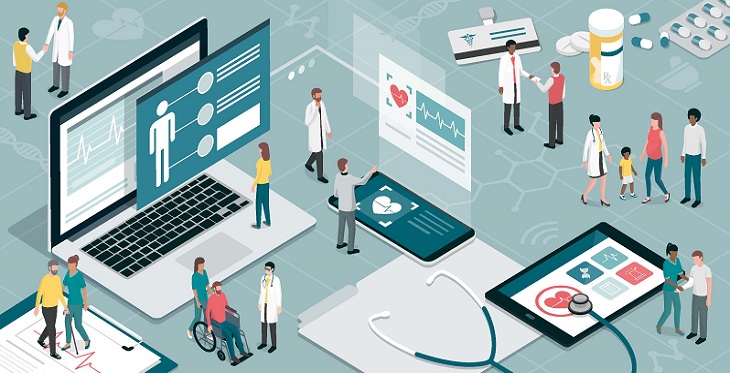Cloud-Based Telehealth Defined: Advantages, Applications, and Security

Telehealth
ICT (Information and communication technology) has transformed the way we see the world by revolutionizing the medical industry and changing the modes of both medical practice and medical service delivery. According to the Center for Connected Health Policy, “Telehealth is a collection of means or methods for enhancing health care, public health, and health education delivery and support using telecommunications technologies. Telehealth encompasses a broad variety of technologies and tactics to deliver virtual medical, health, and education services.”1 Telehealth is widely used to support patients with chronic health conditions. Telehealth has real benefits for both patients and clinicians; it can help patients to better manage and understand long-term health conditions and it can help clinicians to track their patients’ health statuses and to intervene in a timely manner when potentially negative trends or abnormal measurements are observed.
Cloud Storage
Cloud storage is a cloud computing model of housing digital data on remote servers accessible via the Internet. The physical environment is owned and managed by a hosting company such as AWS (Amazon Web Services), Microsoft, or IBM. These providers are responsible for keeping data and applications up and running in addition to providing full data security and availability. Companies can buy or lease storage capacity from providers and use it for storing data and running applications. This decreases the upfront investment in IT infrastructure allowing companies to only pay for what they use (see this article by NetApp for more details on cloud storage costs).
Advantages of Cloud Storage:
- Bandwidth: instead of emailing large files across a network, a simple link to a cloud storage folder can be used to give access to those files.
- Accessibility: stored cloud files are accessible via an Internet connection from anywhere and any device with authorized access..
- Disaster Recovery: the cloud can be used to recover important company data in the event a human-induced or natural disaster causes on on-premise systems failure.
- Cost Savings[1] : when storing data in the cloud, you pay for the cost of storage alone. If storing data locally, you need to pay software and hardware expenses, and you need to pay to power the hardware that stores your files.
Disadvantages of Cloud Storage:
- Performance: higher latency compared to local, on-premise storage can lead to performance bottlenecks when accessing data.
- Data security and governance: there are concerns with entrusting the safety and privacy of important data to a third-party provider. Furthermore, compliance issues can arise when certain types of data end up in cloud systems.
AWS leads the way in the cloud servicing battle among companies like Microsoft, IBM, and Google, according to reports by both Gartner and Synergy Research. Cloud storage solutions like AWS are designed to deliver secure, scalable, and durable storage for businesses. In addition to avoiding any upfront costs of new hardware to store data or run applications, cloud services avoid the hassle of setting up and maintaining an on-premises system. [2] [3]
Cloud-based Telehealth System
Telehealth can save time for healthcare organizations by providing secure, user friendly access to medical records for both clinicians and patients from anywhere they can access the Internet. Some companies are now using secure HIPAA compliant cloud services to store medical records so that patients can access their test results online 24/7, which, in turn, decreases costs associated with paper records, provides increased accessibility for patients to their data, and saves time for everyone that needs to access medical records. Telehealth can also decrease crowds in hospitals and healthcare organizations, resulting in lower infection rates.
Cloud computing systems offer advantages to healthcare providers compared to in-house client-server systems, including economic, operational, and functional advantages. Cloud computing provides cost flexibility and the potential for reduced costs. Computing resources can be acquired on-demand as needed. This can also reduce IT maintenance costs and save time associated with hardware and software acquisition and deployment.
From the operational point of view, cloud services are scalable and flexible. Additionally, the cloud offers better security and privacy for health data and health systems. Cloud providers offer security controls like data encryption and fine-grained access controls and access logging. Some cloud service providers offer 99.99999 percent availability of stored data. Healthcare organizations should look to partner with cloud providers that comply with regulations for healthcare data, such as HIPAA.
Functional benefits include better integration and better interoperability. [4] Cloud services provide access to a broad ecosystem of services for the healthcare provider, including life sciences, payment options and IT solution partners.
The benefits provided by a cloud-based telehealth system can help in accelerating a new business model for healthcare organizations by increasing performance and efficiency.
TeleHealth Application Domain
Telehealth has 4 distinct domains of applications:
- Live video (synchronous)
- Store-and-forward (asynchronous)
- Remote patient monitoring (RPM)
- Mobile Health (mHealth or mCare)
- Live video (synchronous): This is a secure, real-time, two-way interaction between a patient and a clinician. Live video can be used for consultation, diagnostic, and treatment services.
- Store-and-forward (asynchronous): This includes the transmission of patient data, recorded videos and digital images such as X-rays and photos via secure communication systems to a specialist, who can then review this information and provide a consultation at a later time. Store-and-forward telemedicine systems can leverage secure cloud storage for its many benefits including on-demand scalability.
- Remote patient monitoring (RPM): This involves medical data collection from an individual in one location via electronic communication technologies, which is transmitted to a provider, or often a nurse call-center, (sometimes via a data processing service) in a different location for use in patient care and support, which may include escalation to a patient’s primary care or specialist physician when warranted. This data can be stored in data warehouses and used for analyzing the patient’s future conditions and understanding their health history.
- Mobile Health (mHealth or mCare): By 2018, it is estimated that 65 percent of interactions with healthcare facilities will occur via mobile devices. Currently, 80 percent of doctors are already using smartphones and medical apps.[5] [6] In the coming years, we can expect personalized telemedicine apps for both patients and clinicians.
Cloud Computing Services for Healthcare[7]
- Population Health Management: Cloud and Big Data analytics can be used to track diseases, map them geographically, and identify key risk areas.
eClinicalWorks, McKesson, Epic Systems
- Diagnostic Support: Development of new SaaS products and services to focus on the expertise required, with a lower cost of operations for healthcare providers. [8]
IBM Merge iConnect, Cloud DX, GE Health Cloud[9] [10]
- Patient Connectivity: Services ensuring patient connectivity to healthcare providers.
eClinicalWorks, Cerner, Kareo[11]
- Data Distribution Services: Enabling the exchange of health-related data between organizations, such as electronic health records, patient images etc.
IBM Merge eMix, Novarad, Sectra[12] [13]
Security Issues and Solutions
The adoption of cloud services in telehealth significantly increases security and patient privacy concerns but at the same time it also provides ease of access to healthcare information on any device at any location to professionals. Cloud solutions must be used without violating a customer’s right to privacy. Cloud computing must be paired with cloud security measures which secure data, ensure trust, and authenticate identities throughout the cloud environment.
HIPAA and Cloud Computing: Combine HIPAA and cloud computing solutions to achieve a strong level of security and consider the following aspects:
Device Management: [14] Mobile devices and tablets used in medical care require correct and secure configuration, management, and maintenance throughout their lifecycle to prevent data loss.
Secured Architecture: In order to protect databases from malware and other cyber attacks, the management of identities, use of strong authentication measures, and securing API’s at the network level is required.
Data Protection and Encryption: This is one of the best ways to secure patient data. If encrypted data falls into the wrong hands, it is not readable, which is imperative if dealing with highly sensitive healthcare information.
Split key encryption is a strong method used to protect data. The cloud storage network is protected by two encryption keys; one is in the hands of the cloud provider and the other is with the healthcare organization.
To conclude, telehealth helps in connecting patients to specialists at their fingertips. Telehealth often provides a more cost effective and accessible way for patients to understand and engage in managing their long term health conditions. Telehealth is a good approach in locations with a lack of transport options, but that do have sufficient broadband internet available. Additionally, it’s useful for patients who suffer from a lack of mobility such as the elderly or disabled, and it can benefit organizations with staffing issues that restrict access to healthcare for some patients. Cloud storage technologies offer many advantages to telehealth systems. Telehealth systems can leverage cloud services and technologies to improve secure critical communications between patients, clinicians and other members of their healthcare team.
References:
- Center for Connected Health Policy “What is Telehealth” http://www.cchpca.org/what-is-telehealth
- Top Five Digital Transformation Trends in Healthcare https://www.forbes.com/sites/danielnewman/2017/03/07/top-five-digital-tr...
